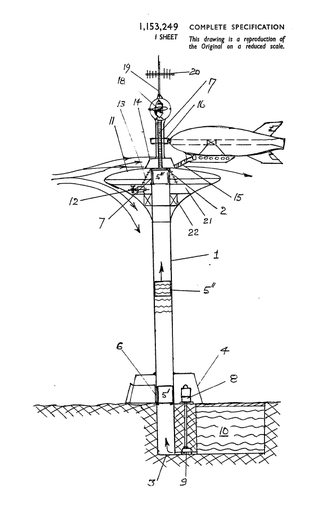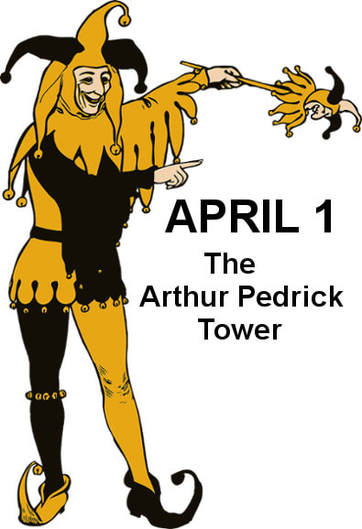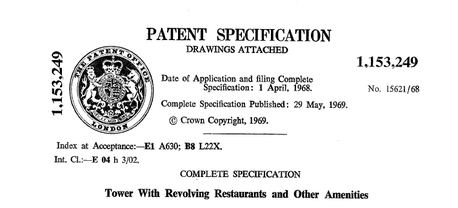|
It's only appropriate that on April Fools Day of 1968, the clown prince of patents, Arthur Paul Pedrick, would file a UK patent application for "Tower with Revolving Restaurants and other Amenities". In the 1960s and 1970s, Pedrick obtained more than 160 patents for wacky and bizarre inventions that were too hopelessly impractical to ever be put into practice. Pedrick never made any money from his patent applications, so why did he file them? Was he crazy? No, perhaps a little eccentric, but not crazy. From his patents, it is apparent that Pedrick was poking fun at the UK Patent Office and making social commentary. |
 Pedrick Tower
Pedrick Tower
Not much is known about Pedrick, except that he was a patent examiner in the UK Patent Office for 14 years and had a cat named Ginger, who was his assistant and confidant, as described in several of his patents. Apparently, Pedrick was let go from the UK Patent Office for inefficiency, which probably explains why he wanted to embarrass them.
After leaving the UK Patent Office, Pedrick began to file patent applications, each one more outrageous than the next. Pedrick hit his stride early, when in 1964, he filed a patent application for a system of pipes for transporting fresh water from Antarctica to the desert region of Australia using ten-foot diameter snowballs that were fed into the pipes in Antarctica and allowed to roll by gravity thousands of miles to Australia.
In his April Fools day patent application, Pedrick proposed a tower for supporting a revolving restaurant that gave diners a panoramic view of the surrounding land. Pedrick's tower had several unique features that distinguished it from other then-existing towers, such as the Space Needle in Seattle. These features included a transparent globe, located above the restaurant, where people could go to engage in "transcendental meditation", a mooring mast for airships and storage tanks for gravity feeding water or beer to houses surrounding the tower. Probably the most unique feature was the manner in which people were transported from the ground level to the restaurant.
A tube extended from the ground to the restaurant and was in communication with liquid in a reservoir. A lift for transporting diners to the restaurant was disposed in the tube. When the lift was at ground level and liquid from the reservoir was pumped into the tube, the lift would rise upward to the restaurant. The pressure of the liquid pumped into the tube was just enough to make the lift and the diners inside positively buoyant. After dinner, the food in the stomachs of the diners was enough to make the lift and the satiated diners negatively buoyant so as to sink to the ground level. Needless to say, the trip to and from the restaurant would be a slow one.
Pedrick envisioned a worldwide network of his towers being serviced by Gas Turbine Hot Air Buoyant Airships (GASTHABs). Making a bit of social commentary, Pedrick wryly noted that with this network of towers, wealthy people "will be able to spend their entire lives off the ground level, moving from one revolving restaurant tower to another by 'GASTHAB' airships, fitted with the necessary sleeping accommodation and there will be no need for them to join the unfortunate 'masses' swarming at ground level."
After leaving the UK Patent Office, Pedrick began to file patent applications, each one more outrageous than the next. Pedrick hit his stride early, when in 1964, he filed a patent application for a system of pipes for transporting fresh water from Antarctica to the desert region of Australia using ten-foot diameter snowballs that were fed into the pipes in Antarctica and allowed to roll by gravity thousands of miles to Australia.
In his April Fools day patent application, Pedrick proposed a tower for supporting a revolving restaurant that gave diners a panoramic view of the surrounding land. Pedrick's tower had several unique features that distinguished it from other then-existing towers, such as the Space Needle in Seattle. These features included a transparent globe, located above the restaurant, where people could go to engage in "transcendental meditation", a mooring mast for airships and storage tanks for gravity feeding water or beer to houses surrounding the tower. Probably the most unique feature was the manner in which people were transported from the ground level to the restaurant.
A tube extended from the ground to the restaurant and was in communication with liquid in a reservoir. A lift for transporting diners to the restaurant was disposed in the tube. When the lift was at ground level and liquid from the reservoir was pumped into the tube, the lift would rise upward to the restaurant. The pressure of the liquid pumped into the tube was just enough to make the lift and the diners inside positively buoyant. After dinner, the food in the stomachs of the diners was enough to make the lift and the satiated diners negatively buoyant so as to sink to the ground level. Needless to say, the trip to and from the restaurant would be a slow one.
Pedrick envisioned a worldwide network of his towers being serviced by Gas Turbine Hot Air Buoyant Airships (GASTHABs). Making a bit of social commentary, Pedrick wryly noted that with this network of towers, wealthy people "will be able to spend their entire lives off the ground level, moving from one revolving restaurant tower to another by 'GASTHAB' airships, fitted with the necessary sleeping accommodation and there will be no need for them to join the unfortunate 'masses' swarming at ground level."



